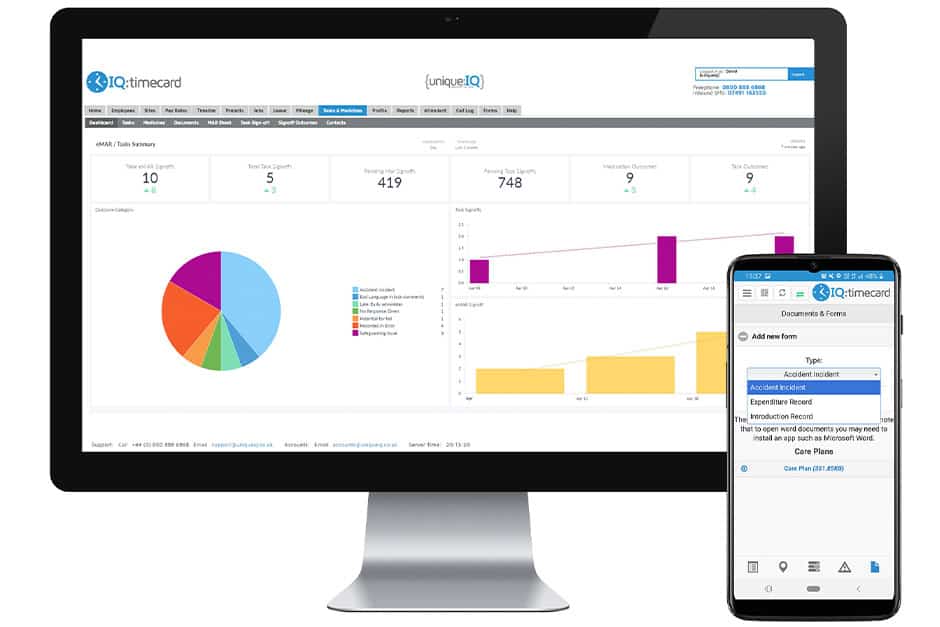
What do good digital care records look like?
The Care Quality Commission’s (CQC) most recent guidance on what ‘good’ looks like for digital care records (released September 2020), outlines the best practice characteristics of an electronic care record, as well as what care providers need to do to achieve this.
Contents
Alongside the announcement from the industry regulator that it intends to make greater use of digital information in its regulatory approach, this guidance is an important facet of making digital records in care the norm.
And by March 2024, the Government is aiming for 80% of CQC-registered providers to have digital social care records.
What are digital care records?
Digital care records refer to electronic records that contain someone’s health and social care information. These records are created and managed by hospitals, clinics, and GP practices, as well as social care providers.
What are digital social care records (DSCR)?
Digital social care records (DSCR) allow the digital recording of care information and care received by an individual, within a social care setting, replacing traditional paper records. DSCRs are person-centred and enable information to be shared securely and in real-time with authorised individuals across the health and care sector.
Like digital care records, digital social care records are designed to improve the sharing of information between healthcare and social care providers, which can lead to better-coordinated care and improved outcomes for patients. They can also help to reduce paperwork and administrative tasks, freeing up time for social care providers to focus on delivering high-quality care.
What does a digital social care record contain?
Digital social care records in the UK typically contain information about an individual’s social care needs, assessments, and care plans. The specific information contained in these records can vary depending on the type of social care being provided, but it may include:
- Personal details: This includes basic information such as the person’s name, date of birth, address, and contact details.
- Medical history: This includes information about any medical conditions or illnesses the person has, as well as details of any medications they are taking.
- Social and emotional needs: This includes information about the person’s mental health, emotional wellbeing, and any social, cultural or practical support they require.
- Risk assessments: This includes information about any risks to the person’s safety or wellbeing, such as risks of falls or abuse.
- Care plans: This includes details of the support or care that the person requires, including any specific interventions, treatments, or therapies.
- Communication preferences: This includes information about how the person prefers to communicate, such as through sign language or with the help of an interpreter.
- Financial information: This includes information about the person’s finances, such as their income, benefits, and any expenses related to their care.
How can care providers create digital social care records?
Care providers are encouraged to utilise comprehensive care management software, to create suitable digital care records that meet the requirements set out by the CQC. Care management technology typically includes all of the features needed to develop complete digital care records.
Overall, creating digital social care records requires careful planning, implementation, and ongoing management to ensure that the records are accurate, up-to-date, and secure.
What are the benefits of digital care records?
Digital transformation is not a new theme in the care sector. Records and processes have been steadily digitising, only accelerated by the events of 2020. When implemented correctly (as the CQC is keen to stress), digital care records can realise some of the following benefits for care providers:
- Real-time information about care delivery
- Greater awareness of when people’s needs change so that they can be responded to more quickly
- The ability to use data to improve people’s care
- Fast sharing of information to other health and care services
- Minimise risks such as medication errors, dehydration or missed visits
- Make it easier for people to access their own records
- Help to support staff to do their job effectively and efficiently
- Easier storage, requiring less physical space
- Support service management, planning and research
- Make better use of resources across the health and care system
What are the characteristics of good digital care records?
A good digital care records system has four key features, according to the CQC. It should:
- Focus on outcomes – for the people that are cared for, as well as in terms of meeting a care provider’s business objectives
- Involve the right people – staff and service users understand the system and how it is used, whilst software suppliers stay involved to make continuous improvements
- Be well managed – new systems are carefully planned, with clear processes for accessing, storing, sharing and backing up information
- Meet relevant standards and regulations – the new digital care records must comply with data protection, data security, consent, privacy and equality legislation
Above all, for the benefit of someone receiving care, electronic care records should have the typical characteristics of a care record in general – that is person-centred, accessible, legible, accurate, complete, up-to-date, available and secure.
What happens during a CQC inspection?

CQC inspectors can ask to see digital care records in the same way that they would ask to see paper records. This will usually happen in one of two ways:
Guest log-in – CQC inspectors are granted temporary permission to log in to a digital care records system, usually with restricted access (i.e. they can view, but not change or delete information)
Supervised access – a senior member of staff logs into the system, allowing the inspector to view the records they need whilst the staff member is present (this could be physically or virtually via a secure screen share)
Making the most of digital care records
You can be assured that our care management software already meets the CQC’s new guidance on digital care records. From having contingency plans in place to meeting data security and data protection regulations, to continuously improving and updating our software in a way that focuses on outcomes both for the care you provide and for your business, we are a partner you can trust.
Discover how IQ:caremanager helps you to meet the CQC Quality Statements
Simply fill in your details below to access your copy of our guide detailing how IQ:caremanager can help you to deliver Outstanding home care. Once submitted, a copy of your guide will be emailed to you.